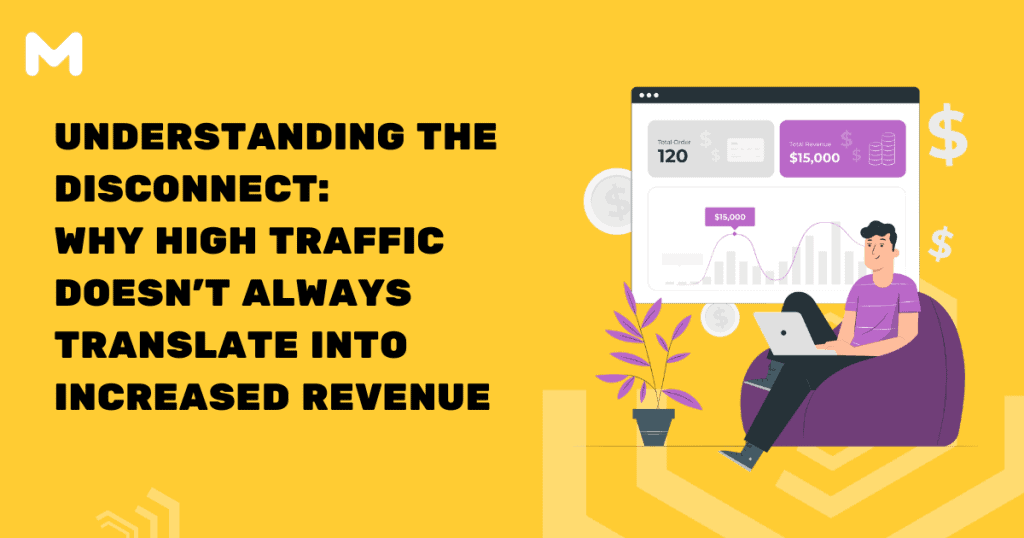In the digital age, businesses rely heavily on online platforms to drive traffic and generate revenue. Google Analytics and digital marketing reports play a vital role in providing insights into website performance. However, there can be instances where these reports show a significant increase in traffic, yet revenue and conversions remain stagnant. This puzzling phenomenon demands a closer examination to understand the underlying factors behind this disconnect.
- Defining the Metrics:
Before delving into the reasons for the discrepancy, it’s important to understand the metrics involved in analyzing website performance.
- Traffic: Traffic refers to the number of visitors a website receives within a specific period. It includes both new and returning users, highlighting the reach and visibility of a website.
- Conversion: Conversion represents the desired action taken by visitors, such as making a purchase, filling out a form, or subscribing to a newsletter. It is a key metric to measure the effectiveness of a website in achieving its goals.
- Quality vs. Quantity:
One common misconception is that high traffic automatically translates into increased revenue. However, the quality of the traffic plays a significant role in determining the conversion rate.
- Targeted Traffic: Not all website visitors are equal in terms of their likelihood to convert. Targeted traffic consists of users who have a genuine interest in the products or services offered by a website. By attracting visitors with a higher potential to convert, businesses increase their chances of generating revenue
- Irrelevant Traffic: On the other hand, an influx of irrelevant traffic can skew the overall conversion rate. Visitors who stumble upon a website but have no genuine interest in its offerings are less likely to convert, resulting in a lower revenue despite increased traffic.
- User Experience (UX) and Conversion Optimization:
A compelling user experience is crucial for converting website visitors into customers. Even with high traffic, if a website fails to provide a seamless and intuitive user experience, visitors may abandon the site before completing the desired action.
- Page Load Speed: Slow-loading web pages can frustrate visitors, leading to higher bounce rates and lower conversion rates. Optimizing page load speed is essential to ensure a positive user experience.
- Mobile Responsiveness: With the increasing use of mobile devices, having a responsive website is paramount. A mobile-friendly design ensures that users can easily navigate, read content, and make purchases, regardless of the device they are using.
- Clear Call-to-Actions: A well-designed website incorporates clear and prominent call-to-action buttons. Visitors should be guided towards the desired action, making it effortless for them to convert.
- Content Relevance and Engagement:
Engaging and relevant content plays a crucial role in attracting and retaining visitors. Merely driving traffic to a website is not enough; it’s equally important to capture visitors’ interest and encourage them to explore further.
- Keyword Relevance: Ensuring that the website’s content aligns with relevant keywords and search intent helps attract targeted traffic. Optimizing content for relevant keywords enables search engines to understand the website’s relevance and rank it accordingly.
- Compelling Headlines: Eye-catching headlines not only improve click-through rates but also entice visitors to stay longer on the website. By delivering compelling and relevant content, businesses can establish credibility and keep visitors engaged.
- Multimedia Elements: Integrating images, videos, and interactive elements can enhance the overall user experience. Engaging multimedia elements make the content more appealing and encourage visitors to spend more time on the website.
- Competitor Analysis:
Analyzing the competition can provide valuable insights into the digital marketing strategies employed by successful businesses within the industry.
- Target Audience Overlap: Identifying the overlap in the target audience between successful competitors and one’s own business helps gain a deeper understanding of what resonates with potential customers. By studying competitor strategies, businesses can refine their own approach and make necessary adjustments to improve conversions.
- Unique Selling Proposition (USP): Analyzing the USP of successful competitors helps identify areas where one’s own business can differentiate itself. Highlighting unique features or benefits can attract visitors and increase the likelihood of conversions.
- Tracking and Analysis:
To bridge the gap between high traffic and low conversions, businesses must continuously track and analyze their website performance. This involves leveraging tools like Google Analytics to gain insights into user behavior, identify bottlenecks, and implement data-driven optimizations.
- Conversion Funnel Analysis: Understanding the conversion funnel, from the initial interaction to the final conversion, allows businesses to pinpoint areas of improvement. Identifying potential drop-off points helps optimize the user journey and increase conversion rates.
- A/B Testing: Conducting A/B tests enables businesses to compare different variations of web pages, content, or designs. By testing and measuring the performance of different elements, one can make informed decisions based on data, driving improvements in conversions.
- Heatmaps and User Session Recordings: Heatmaps and user session recordings provide visual representations of user behavior on a website. They offer valuable insights into where users are clicking, scrolling, or getting stuck, allowing businesses to optimize the user experience and improve conversion rates.
Understanding The Relation Between High Traffic & Conversion
While high traffic is undoubtedly an essential aspect of a successful online presence, it does not guarantee increased revenue and conversions. To bridge the gap between impressive website traffic and lackluster conversions, businesses must focus on several key factors.
In conclusion, the disconnect between high traffic and low conversions can be attributed to various factors, such as the quality of traffic, user experience, content relevance, and competitor analysis. By addressing these areas and implementing data-driven optimizations, businesses can bridge the gap and achieve the desired revenue growth and conversions they strive for.


